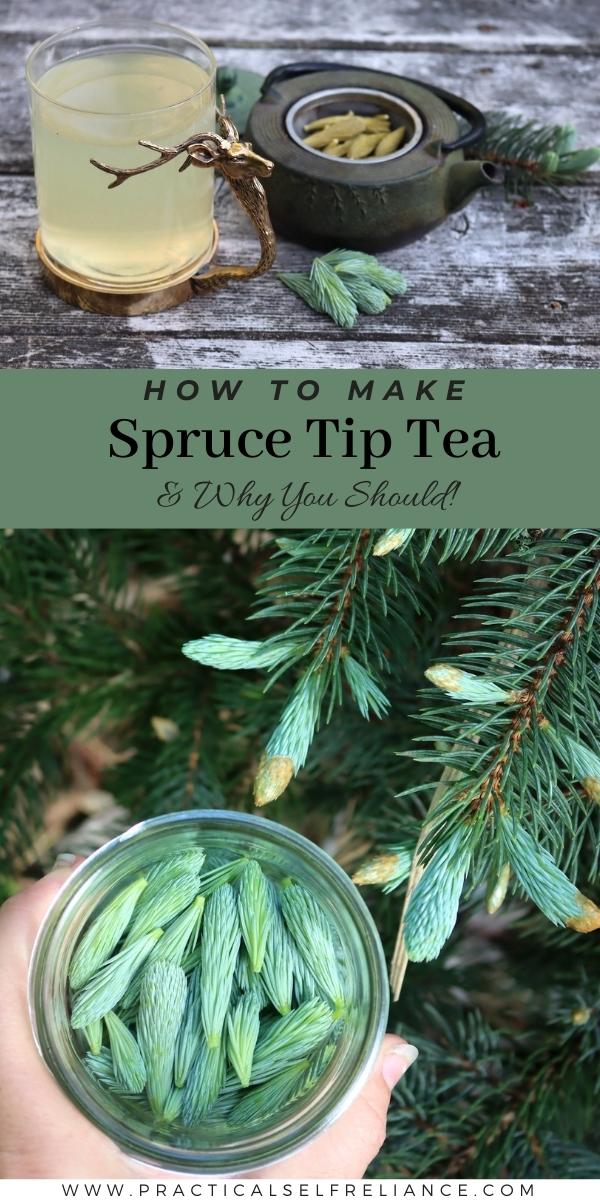Affiliate disclosure: This post may contain affiliate links. Please see our Privacy Policy.
Spruce tip tea is a delicious way to enjoy fresh spruce tips in season. Here’s everything you need to know about making spruce tip tea, as well tips for identifying, foraging, and consuming this delicious conifer.

Learning to make spruce tip tea might seem like a purely functional survival tactic (which, historically it has been and, as you’ll learn, could potentially still function that way), but it’s also a sensual way to experience the delicious, citrus-y flavors that are all found in the humble spruce tip.
When harvested in the springtime, tea made from spruce tips has a slight natural sweetness that pairs well with lime and honey. If you’ve never enjoyed this type of tea before, you might be surprised by how energizing and bright the taste of spruce-tip tea can be.
Also a source of vitamin C, spruce tips contain enough of this powerful antioxidant to keep you from developing scurvy if you were ever stranded in the woods.
Whether you’re interested in survival tactics or simply looking for an interesting cuppa made from freshly harvested spruce tips, read on to learn all about how to make this very special-treat-of-a-tea.
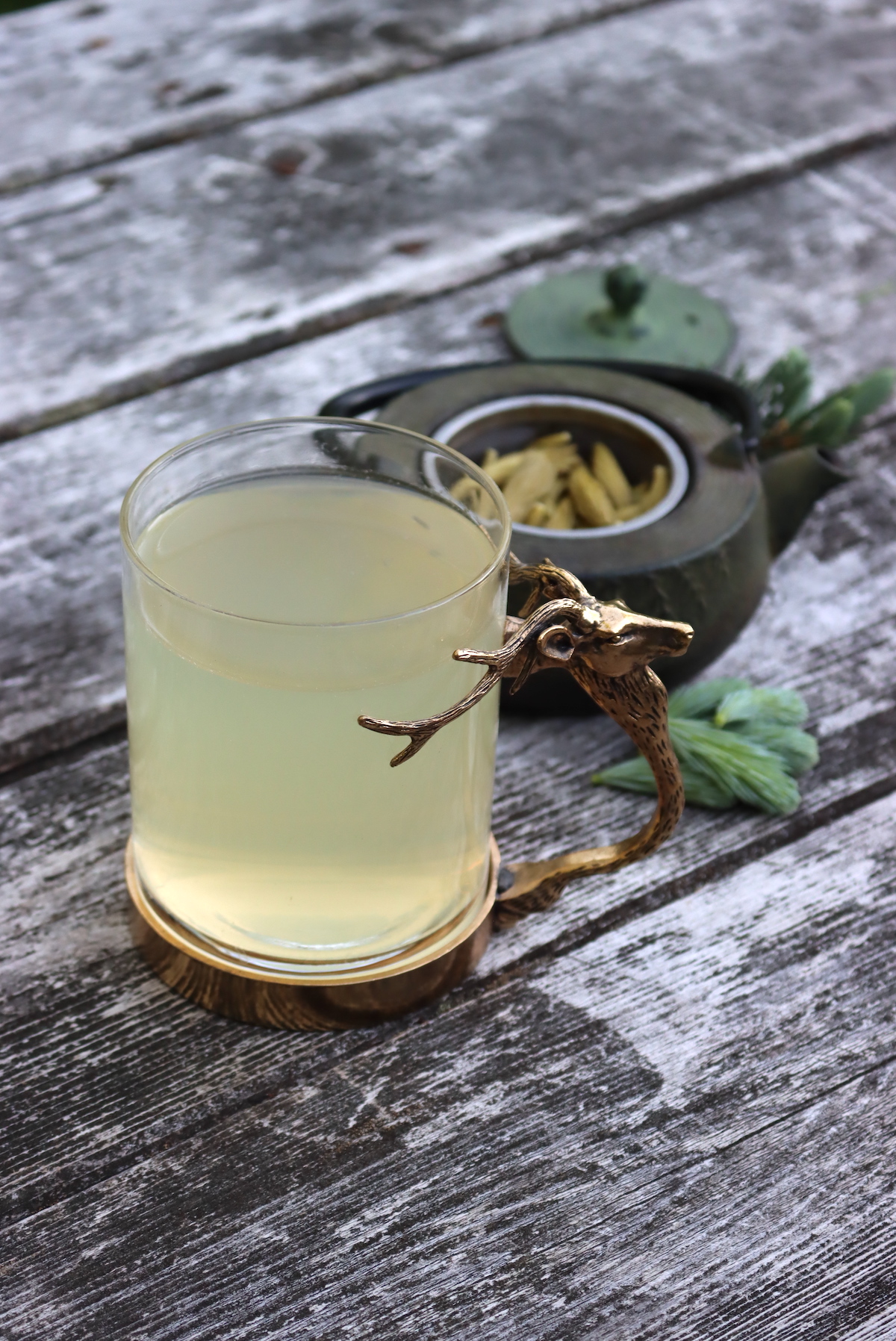
Identifying Conifers
If you want to make spruce tip tea you’ll need to be able to identify a spruce tree in the wild. Other conifers, such as pine and hemlock trees, look quite similar (and luckily, are safe and delicious to consume). It’s important to note that hemlock trees are not the same as poison hemlock, which is is a flowering plant and completely unrelated to hemlock trees.
Pine needle tea is actually equally delicious but tastes quite different. It’s warm and resinous, like pine of course…while spruce tip tea is bright and citrus-y, in a way that’s surprising coming from an evergreen tree.
The one kind of conifer to avoid is the yew tree as it’s highly toxic—it only takes 50 grams (a little under 2 ounces) of needles, berries, or bark to cause lethal cardiogenic shock—so be sure to avoid this somewhat similar-looking tree. I have a bit more information on identifying yew (to avoid it) in my article on poisonous berries, as the berries are what’s most often accidentally consumed. There’s also a good article on identifying various types of conifers, but here are the basics.
Spruce needles are stiff, sharp, short, and have pointy tips. The branches of a spruce tree grow in an upturned direction and the cones, which hang towards the ground, are smooth with thin scales. The bark on a spruce tree is rough and scaly, this helps guide the branches upwards as they grow.
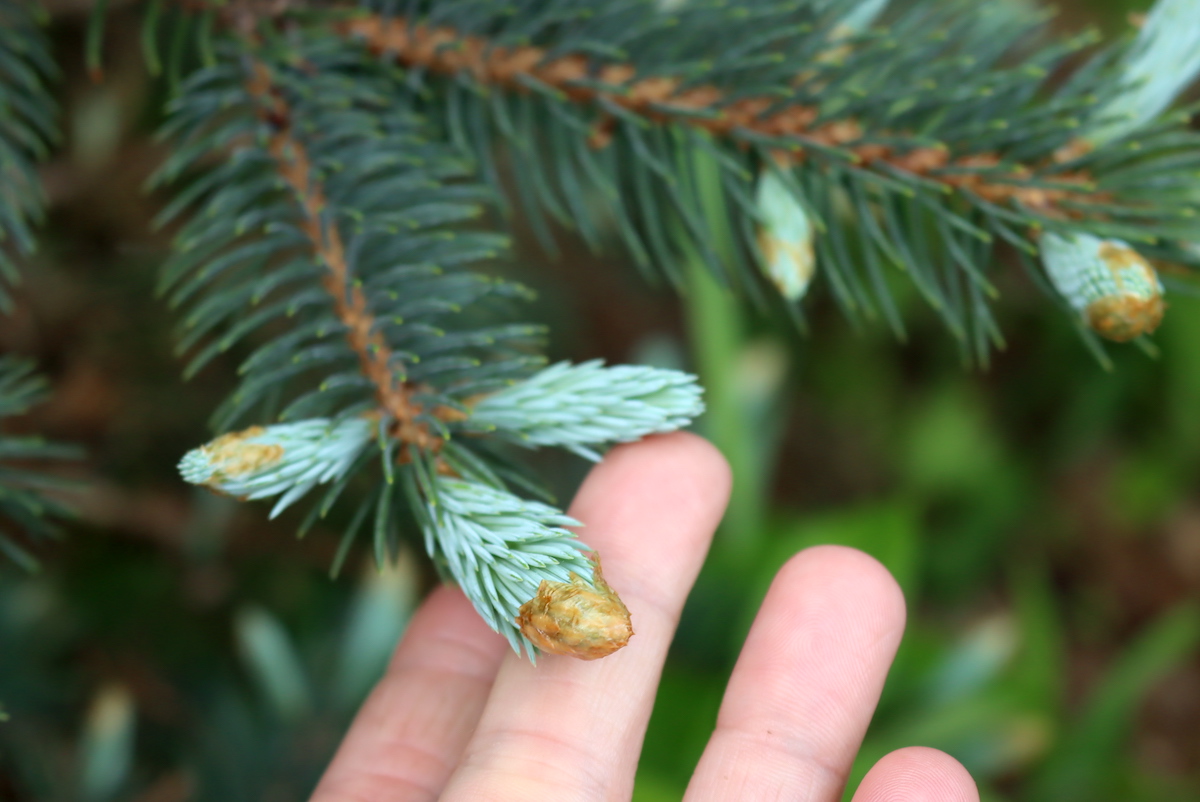
Harvesting Spruce Tips
Begin harvesting spruce tips as early as possible or as soon as you see them growing out of their brown papery husks. Spruce tip season is quite short, the tips are usually gone by mid-June. The tips are easily spotted once you know what you’re looking for and will be a brilliant lime green color.
As with any sustainable foraging endeavor, take care to harvest the side tips only (don’t remove the leader tip) and only take a couple of tips from each tree.
Once harvested, fresh spruce tips should be used as soon as possible. If you plan on keeping the spruce tips around for more than a few days, store spruce tips in the fridge. To do this, place the tips in an unsealed plastic bag with a damp paper towel—swap out the paper towel for a fresh one every week or so for longer-term storage.
Another way to store fresh spruce tips is to freeze them in a single layer on a baking sheet. Once frozen, the tips can be transferred to a bag or container and kept in the freezer, where I try to use them within a 6 month period.
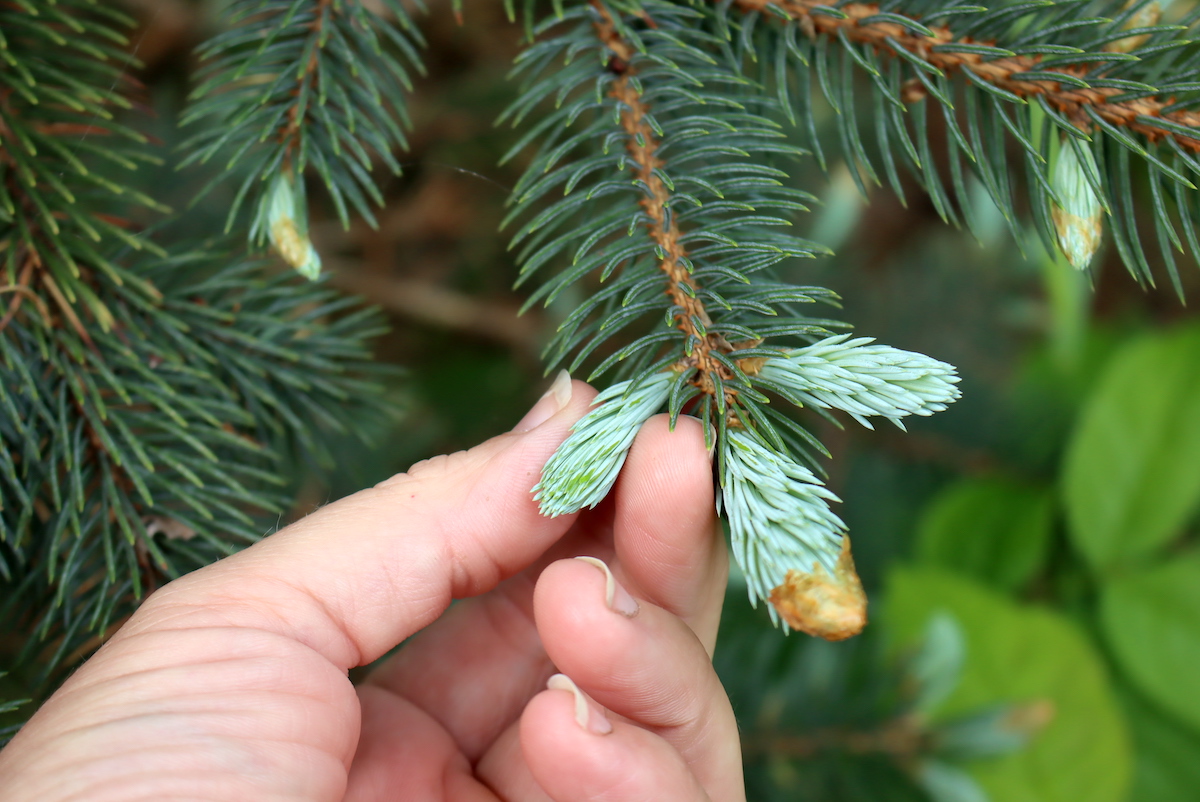
Vitamin C Content of Spruce Tips
Spruce tips are a source of vitamin C, and while they might not be the most robust source when compared to other fruits and vegetables, they contain enough of this powerful antioxidant that you could potentially fend off scurvy by foraging for the tips. By dry weight, spruce tips contain about 406.7 mg of vitamin C per 100 grams (roughly 3.5 ounces); keep in mind that the average spruce tip weighs ~1 gram, so you’d need to consume a lot of spruce tips to reach that level of vitamin C.
One practical application of consuming spruce tip tea has to do with iron absorption. Vitamin C improves your body’s ability to absorb non-heme iron (iron that is derived, for the most part, from plant sources). Sipping on spruce tip tea while you’re eating is an easy way to maximize iron absorption; you can serve the tea hot or make an iced tea by chilling it in the fridge first.
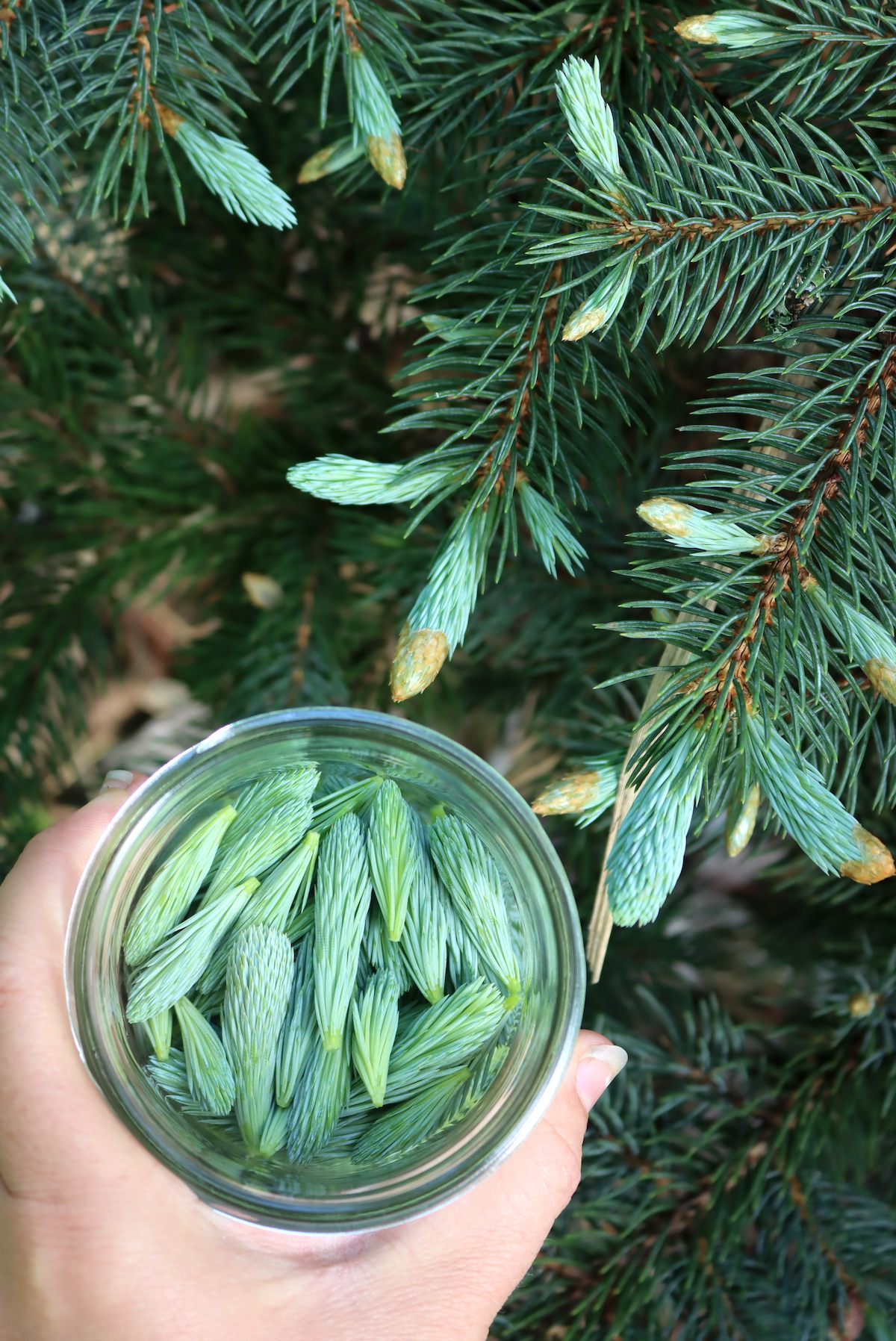
Nutrients in Spruce Tips
As with many plant-based foods, spruce tips are at their nutritional peak when consumed fresh or flash-frozen. The nutritional value also varies depending on whether the tips or needles are being consumed. For example, one study found that freshly harvested Norway spruce had 2.7 times higher protein content than older, dried needles. In addition to vitamin C, spruce tips are a source of potassium, phosphorus, and magnesium; folate and beta-carotene are also present in smaller amounts.
One important word of caution: do not consume any tea made from an evergreen plant if you’re pregnant as it may cause a miscarriage.
How to Make Spruce Tip Tea
Making spruce tip tea is a straightforward process, all you need is the spruce tips, a tea pot (or vessel to let the tips soak in water), and a tea strainer. Honey and lime juice are delicious additions, and work together to really highlight the citrus-y notes of the spruce tips.
Add the spruce tips to the teapot and cover with boiling water. The amount of spruce tips you add will depend on how strong you like your tea, but I typically use about 1/4 to 1/3-cup of spruce tips for every cup of water.
Let the spruce tips steep for 10 to 15 minutes before pouring through a tea strainer. Stir in any extra add-ins you might like, and enjoy the tea hot or cold.
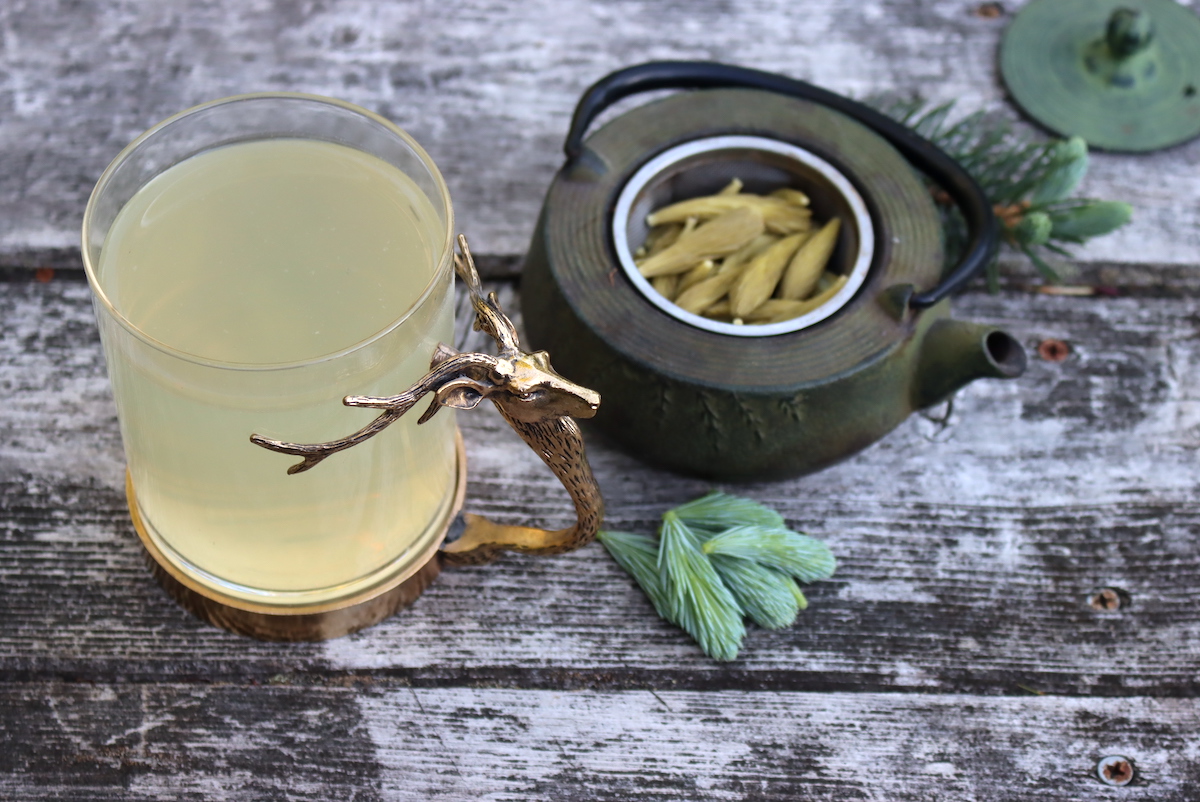
What Does Spruce Tip Tea Taste Like?
The flavor of spruce tip tea will vary depending on the variety of tree the tips have been harvested from, but common underlying notes are bright citrus and a pleasant, slightly-sweet resin-y taste.
Spruce Tip Recipes
Spruce tips can be used to make all sorts of recipes, tea is just one application! Found in both savory and sweet dishes, try making these recipes next time you’re flush with fresh spruce trips:
